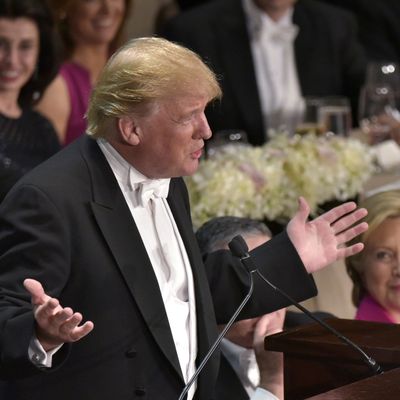
One of the pivotal demographic groups Donald Trump is struggling with is Catholics, who often closely represent American public opinion as a whole (Obama won them by 2 points in 2012). You might guess Trump’s “Catholic problem” is largely the result of his manifest unpopularity among Latinos, the fastest-growing category of U.S. Catholics. But no: A recent poll from the Public Religion Research Institute showed him running behind Hillary Clinton among white Catholics, a pretty reliable GOP-leaning group for many years.
It is hard to sort out cause and effect here, but Trump continues to blunder in ways that hurt him with Catholics. Trying to show his religion bona fides early in the nomination contest, the mogul talked about eating “my little cracker,” a reference to the Eucharist that probably drew a wince from a lot of Catholics (and, for that matter, Orthodox Christians or some Protestants) who are highly reverent toward the Most Blessed Sacrament. This was the same Frank Luntz interview, moreover, when Trump seemed puzzled at the idea of asking God for forgiveness, which likely offended Christians of every persuasion. Then there was the Sunday when he dropped cash in a communion plate — a pretty dramatic exhibition of his leanings toward the Church of the Golden Calf. That was shortly before he called Pope Francis “disgraceful” for questioning the compatibility of nativism with Christianity.
Perhaps justifiably frantic about Trump’s weakness among Catholics, his supporters tried to make the case that one of John Podesta’s illegally stolen batch of emails showed Clinton staffers betraying a hatred of Catholicism. This claim did not much survive the realization that all of the staffers involved in the brief discussion of Catholicism in question are themselves Catholics. And as conservative Catholic Ross Douthat quickly explained, the “anti-Catholic” utterances in those emails actually reflect differences of opinion between progressive and “traditionalist” Catholics.
You’d think an outsider like Trump might not have trotted out this line of attack against Clinton in an audience very familiar with the long-standing “Catholic civil war” between modernizers and their co-religionist rivals —you know, an audience like the one at the annual Al Smith dinner in New York, a traditionally jovial charity event both major-party presidential candidates usually attend in order to lob good-natured jibes at each other. Some observers think both candidates broke the rules at last night’s Al Smith dinner, while others believe Trump was the prime offender. Either way, it was Trump who tried to make Catholicism itself a campaign issue with a ham-handed allusion to the Podesta emails:
We’ve learned so much from WikiLeaks. For example, Hillary believes that it’s vital to deceive the people by having one public policy and a totally different policy in private — That’s okay, I don’t know who they’re angry at, Hillary, you or I. For example, here she is tonight, in public, pretending not to hate Catholics.
Not exactly a knee-slapper, was it? And it was roundly booed in a roomful of people who — whatever their politics — knew it was total BS.
Trump should probably leave Catholics alone between now and November 8. Matter of fact, given the tensions his recent and past behavior is creating among the heavily Republican conservative white evangelical constituency, he might want to give Christianity in general a wide berth.





























